Much has been written on the amendments to the International Health Regulations (IHR), which most countries are making themselves subject to after July 19th (next week). Many raise concerns of loss of sovereignty, censorship, corporate greed, and conflict of interest. But most are missing the main point; the sheer and outright stupidity and fallacy on which the whole pandemic agenda is based.
July 19th is the last day that Member States of the World Health Organization (WHO) can withdraw from the IHR amendments (without entering a multi-year withdrawal process). By failing to withdraw, they will be committing their taxpayers to fund the key surveillance aspects of a rapidly expanding industry that is the pandemic industrial complex. They will be required to set up an extensive network to search for well-established natural phenomena, including the tendency of viruses to mutate into variants. This has been part of the natural world for hundreds of millions of years, but demonstrating it has recently become highly profitable due to a confluence of technological advances and intense marketing.
Firstly, we have developed the ability to detect variants with technologies such as PCR and gene sequencing. This also helps find a lot of viruses that we had not noticed before as they are mostly harmless. Secondly, we have developed digital identification and communications technologies that allow an unprecedented level of mass media coordination and public coercion – what Goebbels could do on a national scale, we can now do almost globally. Thirdly, we have developed pay-to-print modified-RNA medicines (vaccines) that are really cheap but, through the use of fear and coercion, can be injected into almost everyone, returning excellent profits.
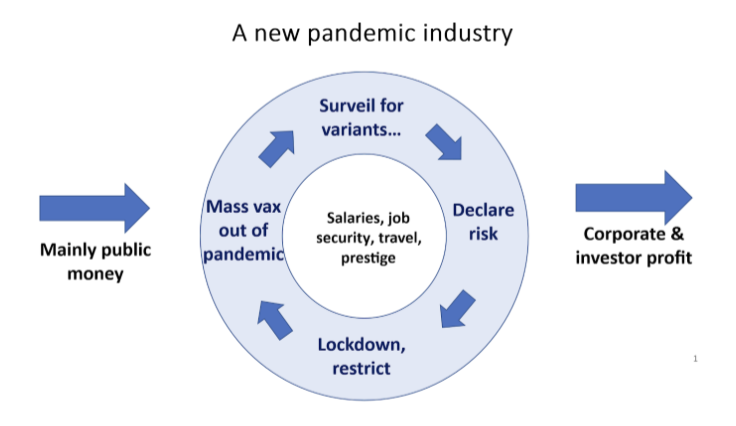
The text of the IHR amendments reads fairly innocuously. Few countries will decline their adoption. The people making the decisions often have career interests in the pandemic industry anyway, and politicians don’t see much gain in standing against the flow of finance. This will flow upward, as it did in Covid, but some of it diverts to their electoral funds. Most think it is better that they get these funds than their opponents. Unfortunately, but obviously, modern democracies are very much about money.
Politics aside, it is worth considering how we got to such a place. The last big natural pandemic was the Spanish flu in 1918-19. That was before we invented any modern antibiotics (most flu deaths were probably from secondary bacterial infections) and before all the gizmos and cleverness of modern medicine. Since then, infectious disease death rates have plummeted because we eat better, have better sanitation and live in better conditions, have modern clinics, and all that technology provides. If the Spanish flu spread now, it is inconceivable that an equivalent virus could cause the same pattern of mortality, unless we really wanted it to. A century of advances in medical technology and human resilience do not amount to anything, as many medical authorities gaining from this would have us believe.
Moderate flu pandemics in the late 1950s and 1960s were the only events since then where a respiratory virus outbreak actually got significantly above baseline for annual mortality (Swine flu [H1N1] in 2009 didn’t). Then came Covid-19, associated with death in wealthy countries at just above the average age of death, and quite probably arising from the research carried out by the same pandemic industry that then profited from it.
This leaves a huge credibility problem in justifying the pandemic agenda that now dominates public health. It is being dealt with by pummeling the public, and politicians, with stories sufficiently farcical that they start to be believed. We still have an urge to believe that institutions such as the WHO, the World Bank, and the G20 would not make stuff up to trick us. Undaunted by the lack of evidence, the WHO set about essentially creating a fiction through their two major outbreak publications of the past 5 years, Managing Epidemics and Future Surveillance, both published in 2023. Once, I am sure, the WHO would not have done this. They base their claim of rising outbreaks on a single graphic showing no outbreaks in the year 2000, but a steady accumulation since. The WHO is insisting that diseases like cholera, plague, Yellow Fever, and influenza, which were far worse in past decades and centuries are actually increasing now. Someone was paid to design this graphic (below) to persuade, rather than impart truth. It is challenging not to characterize this as fraud, but it is consistent with WHO messaging on this issue since early 2020.
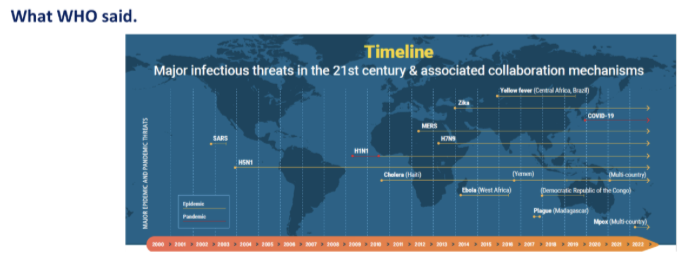
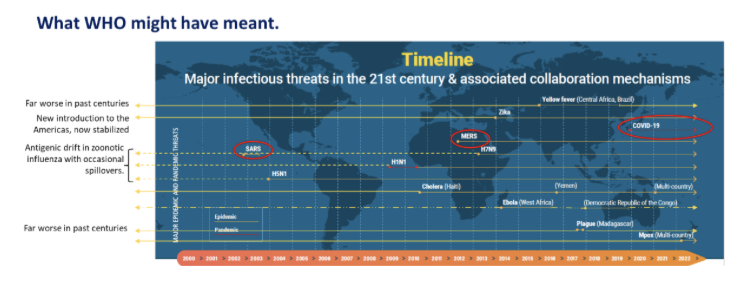
In the 20 years prior to Covid-19, experts recruited by the G20 to present evidence supporting the IHR amendments could only find outbreaks amounting to about 190,000 deaths in the 20 years pre-Covid (“see major infectious disease outbreaks” in Annex D) of the 2022 G20 report. Putting numbers to these, nearly all (163,000) are attributed to Swine flu in 2009 (about a quarter of normal yearly flu mortality). Most of the remainder were from the geographically confined West African Ebola outbreak, and the Haiti cholera outbreak which arose from sewerage leaking from a United Nations compound. In contrast, about 1.3 million people currently die every year from tuberculosis and over 600,000 children from malaria. Roughly 100 million died from malaria, tuberculosis, and HIV/AIDS combined over the same 20-year period. Undaunted, the G20 secretariat concluded that the acute outbreak above constituted an “existential threat” justifying far more resources.
Not to be outdone, the World Bank teamed up with the WHO to provide an explanatory graphic in their official report aimed at convincing our governments to divert funds to pandemics rather than the major endemic diseases; malaria, tuberculosis, and HIV/AIDS. To justify public money being allocated to profitable pandemic preparedness rather than high-burden diseases, they needed to show that pandemics cost economies far more. They drew a line for malaria, tuberculosis, and HIV/AIDS combined at $22 billion per year (i.e. probably about 1% or 2% of true cost). Then they drew a wavy line above this to indicate that SARS1 (840 deaths) and MERS (about 800 deaths) cost $50-70 billion.
Covid is costed at over $9 trillion, which clearly includes costs of lockdowns and incentive packages from the extraordinary response. A Lancet article that the WHO would have previously agreed with estimated annual economic costs of tuberculosis alone to be $508 billion, but the WHO and the World Bank chose $22 billion for TB, malaria, and HIV combined. The WHO considers a virus killing at average age of about 80 years is orders of magnitude more expensive than three diseases that have killed about 100 million, mostly children and young adults, in just 20 years.
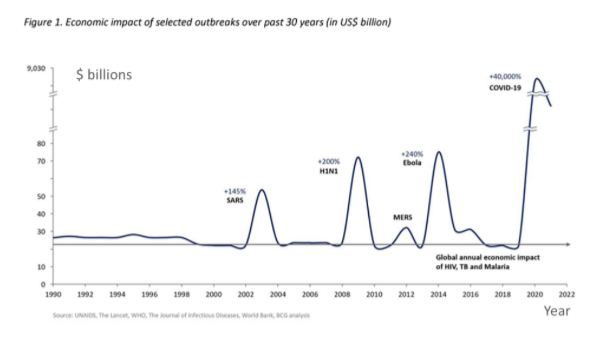
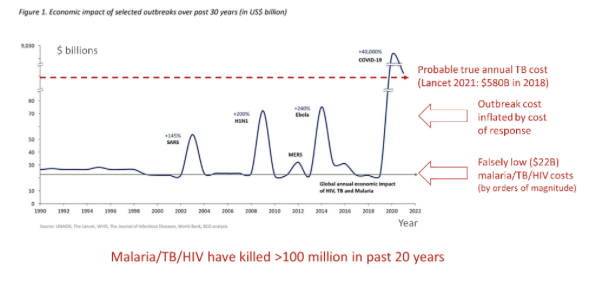
There is far more extensive evidence of the WHO and partner agencies misleading the public, media, and governments to promote the pandemic agenda. Writing about this is not fun. It is a deliberate misrepresentation intended to divert funds to wealthier nations, their corporations, and investors, increasing inequality and causing net harm. The private sector and a few countries can control most of the WHO’s work through specified funding. Member States go along because delegates want a job with the same agencies or refuse to accept that these agencies fabricate a story, even when a cursory review shows their claims are exaggerated or unfounded.
Even though the main proponents of the IHR amendments cannot articulate a coherent case for having them, they will come into force. This is simply about building an industry to repeat Covid; taking money from the larger but less profitable disease burdens, printing more, and concentrating this wealth amongst those promoting the new normal. The exact opposite of what the WHO is supposed to do.
The United States and Argentina have stated their intent to leave the WHO. We will see how that lasts. The era of principles and ideals is long gone from international health. More money will be channeled to ever-growing bureaucracies whose sole function, whose only reason for existence, is to identify theoretical threats that can be used to close economies, remove the livelihoods of others, and extract more of their remaining wealth. The hapless inhabitants of WHO Member States seem to have no real leaders anymore. Eventually, the whole edifice will collapse under the weight of its own fallacies and economic unsustainability. In the meantime, the sad corporatist mess that international public health has become will continue to be in debt and demoralize its public.






